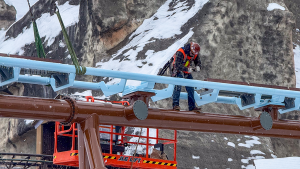Entrepreneur and former contractor David Peters has developed a smartphone app that automatically tracks and records the hours worked by  employees of construction companies.
Called Construction Clock, the app leverages the technology of the smart phone that almost every crew member has in their pocket.
Peters, who is founder and CEO of Construction Clock Inc., said the app is better than pen and paper at keeping track of the hours of multiple employees over multiple jobsites. The old-fashioned way is messy, inefficient and can lead to errors in calculation.
“Most crews are currently using paper timesheets or a shared spreadsheet of some sort, in which each person enters their hours as they themselves have tracked them,” said Peters. “Our app eliminates that, which means the hours worked by each crew member are recorded with 100 per cent accuracy, with no user input required.”
Peters said the app is “basically forgettable” by crew members.
“At the end of each pay period, the owner or foreman simply sends the summary to the bookkeeper for payroll, where the hours are organized by crew, project and employee,” said Peters.
What makes Construction Clock different from other time-tracking apps, he said, is that it is tailored to the unique requirements of the construction industry. Peters also believes it is the only app that tracks time by “hands-free” geo-location technology.
“Crew members don’t have to remember to clock in manually on their phones in order to start the timer,” he said. “As soon as they enter the worksite, the geo-location technology in Construction Clock automatically clocks them in. And, when they leave the site, it automatically clocks them out.”
Peters said the app improves time-keeping accuracy by an average of three hours per week per employee, because it tracks and records the actual time a crew member has worked, instead of time that has been rounded off to the nearest half- or quarter-hour, which sometimes happens when recording hours worked with pen and paper.
“Construction Clock also saves an average of eight hours of administration work per month,” said Peters. “For a small contractor, that’s a big saving.”
Although the nominal head office of Construction Clock is in Winnipeg, the company is “fully remote,” in Peters’ words, with 19 employees in different parts of şÚÁĎłÔąĎÍř and Ukraine.
Construction Clock’s target market has been small- and medium-size contractors (SMEs), of between three and 12 employees, that are willing to try new technologies.Â
“I’m also starting to go after larger companies with 13 or more employees,” he said.
Peters said he is focusing his attention now on developing working relationships with other software developers and making Construction Clock compatible with their software.
Digital technologies for the construction industry, of which there are many different kinds on the market, can be a real boon to SMEs.
“Three-quarters of Canadian construction companies have five employees or fewer,” said Mary Van Buren, president of the Canadian Construction Association. “They face the same challenges as the big companies, such as access to labour, fair procurement and high interest rates. But they also have their own problems, many of which are the result of not having enough time.”
Caleigh Bradbury, a project co-ordinator at Kindred Construction Ltd. in Vancouver, said the biggest benefit of digital technology to construction companies is that it can reduce errors.
“It’s easy to make mistakes, and mistakes cost money,” said Bradbury. “Instead, build twice. The first time, build digitally, so you can get all the glitches out. Then build it right onsite.”
Helen Goodland, head of research and innovation at Scius Advisory, a Vancouver consulting firm, said although there is an ever-growing number of digital tools available to help SMEs become more productive and efficient, the informational infrastructure for bringing technology to the construction industry is missing.
“There’s so much smoke and mirrors, with exaggerated claims by technology manufacturers,” said Goodland. “There’s a lot of information to sift through, and most SMEs don’t have the time or the expertise to do it.”
Joe Geluch, president of Naikoon Contracting Ltd. in north Vancouver said, “The technology is here, it’s ready and it works. It’s the adoption and implementation of it into our largely dysfunctional AEC (architecture, engineering, construction) industry that is the issue, which needs to be solved in order to create less waste and better productivity.Â
“Fix the process first and then apply the technology to optimize it.”








Recent Comments
comments for this post are closed